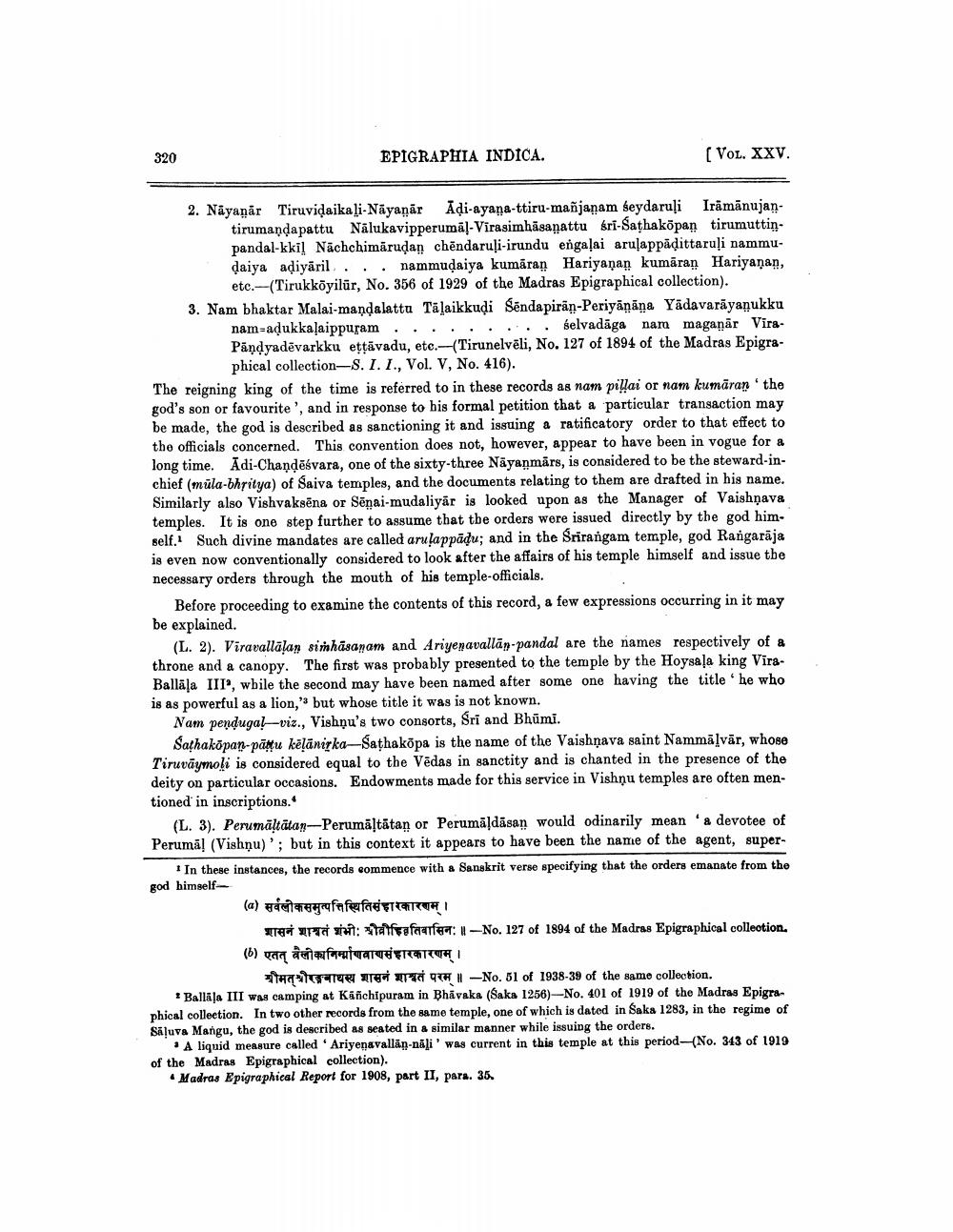________________
320
EPIGRAPHIA INDICA.
(Vol. XXV.
2. Nayanar Tiruvidaika li-Nayanar Adi-ayana-ttiru-mañjanam seydaruļi Irāmānujan.
tirumaņdapattu Nālukavipperumal-Vīrasimhasanattu sri-Sathakopan tirumuttinpandal-kki! Nächchimārudan chēndaruļi-irundu engaļai arulappădittaruli nammudaiya adiyäril... nammudaiya kumāran Hariyanan kumāran Hariyanan,
etc.--(Tirukköyilür, No. 356 of 1929 of the Madras Epigraphical collection). 3. Nam bhaktar Malai-mandalattu Tālaikkuļi Sēnda piran-Periyāṇāna Yādavarāyaṇukku
nam-adukkaļaippuram ......... selvadāga nam magaņār ViraPandyadēvarkku ettävadu, etc.-(Tirunelvēli, No. 127 of 1894 of the Madras Epigra
phical collection-S. I. I., Vol. V, No. 416). The reigning king of the time is referred to in these records as nam pillai or nam kumāran the god's son or favourite', and in response to his formal petition that a particular transaction may be made, the god is described as sanctioning it and issuing a ratificatory order to that effect to the officials concerned. This convention does not, however, appear to have been in vogue for a long time. Adi-Chandēśvara, one of the sixty-three Näyanmārs, is considered to be the steward-inchief (müla-bhritya) of Saiva temples, and the documents relating to them are drafted in his name. Similarly also Vishvaksēna or Sēnai-mudaliyār is looked upon as the Manager of Vaishṇava temples. It is one step further to assume that the orders were issued directly by the god him. self. Such divine mandates are called arulappādu; and in the Srirangam temple, god Rangarāja is even now conventionally considered to look after the affairs of his temple himself and issue the necessary orders through the mouth of his temple-officials.
Before proceeding to examine the contents of this record, a few expressions occurring in it may be explained.
(L. 2). Viravallalan simhasanam and Ariyenavallām-pandal are the names respectively of a throne and a canopy. The first was probably presented to the temple by the Hoysaļa king ViraBallāļa III', while the second may have been named after some one having the title he who is as powerful as a lion,' but whose title it was is not known.
Nam pendugal-viz., Vishņu's two consorts, Sri and Bhūmi.
Sathakopan-pātu kēlānirka-Sathakõpa is the name of the Vaishnava saint Nammāsvār, whose Tiruvāymoli is considered equal to the Vēdas in sanctity and is chanted in the presence of the deity on particular occasions. Endowments made for this service in Vishnu temples are often mentioned in inscriptions.
(L. 3). Perumältātan-Perumältātan or Perumaldāsan would odinarily mean a devotee of Peruma! (Vishnu)'; but in this context it appears to have been the name of the agent, super
* In these instances, the records commence with a Sanskrit verse specifying that the orders emanate from the god himself
(a) सर्वलोकसमुत्पत्तिस्थितिसंहारकारणम् ।
TË PTT a tallsafafea: 1 No. 127 of 1894 of the Madras Epigraphical collection. (6) van denafarufuardTATTI
thr er H TT No. 61 of 1938-39 of the same collection. * Ballāļa III was camping at Kanchipuram in Bhävaka (Saka 1256)--No. 401 of 1919 of the Madras Epigram phical colletion. In two other records from the same temple, one of which is dated in Saka 1283, in the regime of Saluva Mangu, the god is described as seated in a similar manner while issuing the orders.
*A liquid measure called 'Ariyenavallānnāli' was current in this temple at this period-(No. 343 of 1919 of the Madras Epigraphical collection).
• Madras Epigraphical Report for 1908, part II, para. 35.




